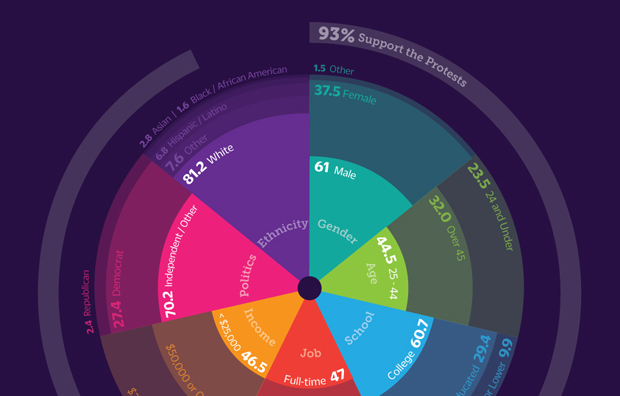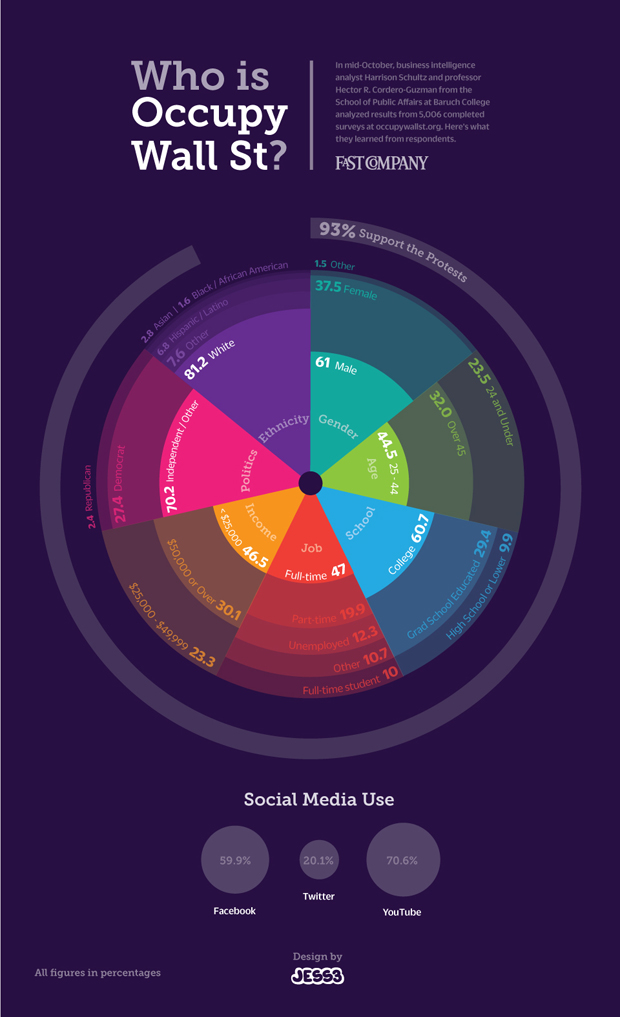A great infographic design evaluating the anarachic protest group, 'Occupy Wall Street'. A great visual- factual, yet eye-catching. Great colour palette too. I need to start making designs like this!
For my programme/mailshot booklets in my Wes Anderson film festival project (which can be found on my Design Practice blog) I will create infographic designs to illustrate specific data about the films and the director, Wes Anderson, himself.Infographic: Who Is Occupy Wall Street?
BY Sean Captain
Visualizing the results of 5,006 completed surveys at
occupywallst.org, data shared exclusively with Fast Company.

The leaderless, anarchic, revolutionary revolution, Occupy Wall Street, continues to evolve. Offshoot Occupy Oakland,
for example, is expected to get support from organized labor and
established advocacy groups for a massive planned demonstration
Wednesday. And now a new study, shared exclusively with Fast Company,
offers insight into participants. They span age and income groups, are
largely apolitical, and are mostly white. They are also getting more
active. (See full-size infographic below)
The movement doesn’t have an official anything. But occupywallst.org,
created by founding volunteer Justine O'Tonnaigh, is the closest thing
to an official website. Between September 18 and October 28, the site
received 4.7 million unique visitors. Business intelligence analyst
Harrison Schultz, who helped develop occupywallst.org, and Professor
Hector R. Cordero-Guzman from the School of Public Affairs at Baruch
College, have been surveying visitors to get a sense of who supports the
movement.
Their initial poll of 1,619 people on October 5 (first reported by Fast Company)
challenged the stereotypes of supporters as mostly students, the
unemployed, and Democrats. But it confirmed that the vast majority are
white.
Fast Company received exclusive access to the latest survey of
5,006 visitors from October 21-22. Many of the results are similar,
making the researchers confident that even surprising findings, such as
70% of respondents calling themselves political independents, were not
flukes.
What did change? Participation in actual protests. In the Oct. 5 survey,
24% of respondents said that they had taken part; in the October 21-22
poll, 43% said they had.
The researchers concede that the web survey is not a perfect measure. In
New York City, for example, while African Americans are certainly in
the minority, Fast Company has seen more than indicated by the 1.6% that appears in the survey.
But with far more participants on the Internet
than in the parks, perhaps the Occupy Wall Street social movement is
best measured by its virtual ranks. And while other sites, such as
occupytogether.org, are growing, occupywallst.org is still the best
known.
Click the image below for the full size infographic, designed by Jess3 for Fast Company.


No comments:
Post a Comment